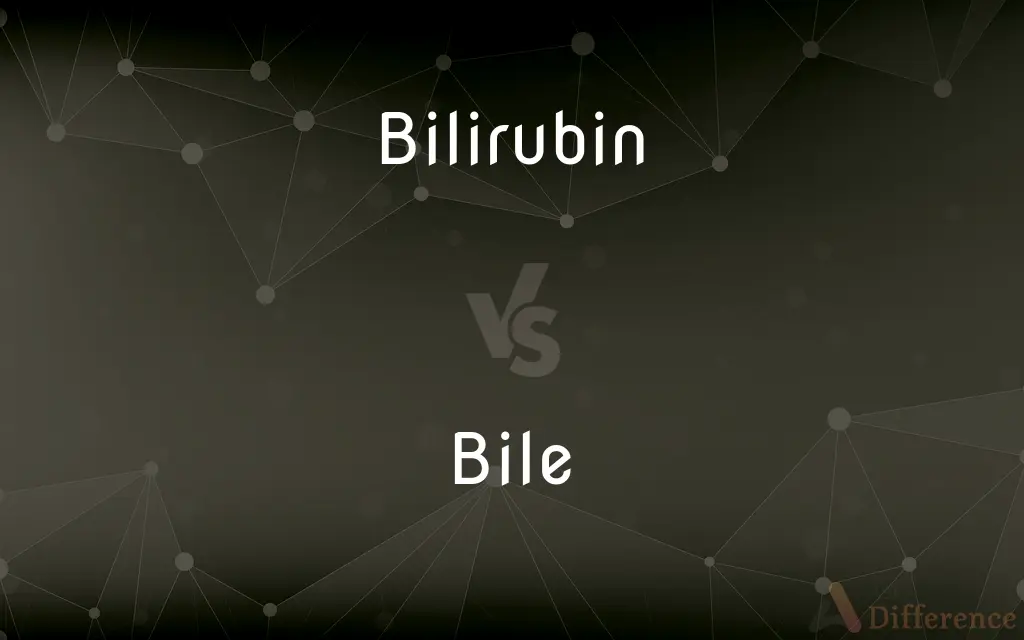Bilirubin vs. Bile — What's the Difference?
Edited by Tayyaba Rehman — By Urooj Arif — Updated on March 8, 2024
Bilirubin is a yellow pigment, a byproduct of red blood cell breakdown, while bile is a fluid produced by the liver, aiding in digestion.

Difference Between Bilirubin and Bile
Table of Contents
ADVERTISEMENT
Key Differences
Bilirubin is a yellow compound that results from the breakdown of hemoglobin in red blood cells. Its primary function is to be processed by the liver and then excreted as part of bile. Whereas bile is a complex fluid containing water, bile acids, cholesterol, and bilirubin, which is produced by the liver and stored in the gallbladder before being released into the intestines to aid in digestion, particularly in the emulsification and absorption of fats.
The production of bilirubin is a continuous process resulting from the body's regular turnover of red blood cells. Elevated levels of bilirubin in the blood can lead to jaundice, a condition characterized by yellowing of the skin and eyes. On the other hand, bile's production and flow are essential for digestive health, and any impairment can result in digestive issues or gallstones.
While bilirubin is a singular component primarily concerned with the disposal of waste products from blood cells, bile serves a broader range of digestive functions. Bilirubin's overaccumulation can indicate liver dysfunction or blockages in bile ducts, whereas issues with bile might point to gallbladder problems or liver disease.
Bilirubin's journey through the body ends with its excretion, mainly through feces, giving them their characteristic color. Bile, however, is recycled via the enterohepatic circulation, where bile acids are reabsorbed from the intestines and returned to the liver for reuse. This cycle is crucial for maintaining the body’s lipid balance.
In essence, bilirubin and bile represent different aspects of the body's metabolic and digestive processes. Bilirubin is focused on waste management and the breakdown of red blood cells, while bile plays a multifaceted role in digestion and nutrient absorption.
ADVERTISEMENT
Comparison Chart
Nature
Yellow pigment, byproduct of hemoglobin breakdown.
Digestive fluid produced by the liver.
Primary Function
Processed and excreted as part of bile.
Aids in the digestion and absorption of fats.
Composition
Singular compound.
Contains bile acids, cholesterol, and bilirubin.
Role in Body
Indicates liver function and red blood cell turnover.
Crucial for digestion, especially fat emulsification.
Associated Conditions
High levels can lead to jaundice.
Impairment can result in digestive issues or gallstones.
Excretion
Through feces.
Recycled via enterohepatic circulation.
Significance
Waste management and breakdown of red blood cells.
Multifaceted role in digestion and nutrient absorption.
Compare with Definitions
Bilirubin
Yellow pigment from hemoglobin breakdown.
Elevated bilirubin levels can cause jaundice.
Bile
Digestive fluid produced by the liver.
Bile is stored in the gallbladder before being released into the intestines.
Bilirubin
Indicator of liver function and red blood cell turnover.
High bilirubin levels may indicate liver problems.
Bile
Issues can lead to digestive problems or gallstones.
Blocked bile ducts can cause digestive distress and jaundice.
Bilirubin
Excreted mainly through feces.
Bilirubin gives feces their characteristic brown color.
Bile
Aids in digestion and nutrient absorption.
Bile emulsifies fats, making them easier to digest.
Bilirubin
Associated with jaundice if levels are high.
Jaundice in newborns is often due to high bilirubin.
Bile
Contains bile acids, cholesterol, and bilirubin.
Bile acids are crucial for fat digestion and absorption.
Bilirubin
Processed by the liver for excretion.
The liver converts bilirubin into a form that can be excreted.
Bile
Recycled via enterohepatic circulation.
Bile acids are reabsorbed from the intestines and returned to the liver.
Bilirubin
Bilirubin (BR) is a yellow compound that occurs in the normal catabolic pathway that breaks down heme in vertebrates. This catabolism is a necessary process in the body's clearance of waste products that arise from the destruction of aged or abnormal red blood cells.
Bile
Bile (from latin bilis), or gall, is a dark-green-to-yellowish-brown fluid produced by the liver of most vertebrates that aids the digestion of lipids in the small intestine. In humans, bile is produced continuously by the liver (liver bile) and stored and concentrated in the gallbladder.
Bilirubin
An orange-yellow pigment formed in the liver by the breakdown of haemoglobin and excreted in bile.
Bile
A bitter, alkaline, brownish-yellow or greenish-yellow fluid that is secreted by the liver, stored in the gallbladder, and discharged into the duodenum and aids in the emulsification, digestion, and absorption of fats. Also called gall1.
Bilirubin
A reddish-yellow bile pigment, C33H36N4O6, derived from the degradation of heme.
Bile
Bitterness of temper; ill humor; irascibility.
Bilirubin
(biochemistry) A bile pigment that is a product of the breakdown of the heme portion of hemoglobin (which occurs within macrophages as they digest red blood cells), and which is responsible for the yellowish color seen in bruises. Extremely high levels of bilirubin may cause jaundice.
Bile
Either of two bodily humors, black bile or yellow bile, in ancient and medieval physiology.
Bilirubin
A reddish yellow pigment present in human bile, and in that from carnivorous and herbivorous animals; the normal biliary pigment.
Bile
A bitter brownish-yellow or greenish-yellow secretion produced by the liver, stored in the gall bladder, and discharged into the duodenum where it aids the process of digestion.
Bilirubin
An orange-yellow pigment in the bile that forms as a product of hemoglobin; excess amounts in the blood produce the yellow appearance observed in jaundice
Bile
Bitterness of temper; ill humour; irascibility.
Bile
Two of the four humours, black bile or yellow bile, in ancient and medieval physiology.
Bile
(obsolete) A boil (kind of swelling).
Bile
Pronunciation spelling of boil
Bile
A yellow, or greenish, viscid fluid, usually alkaline in reaction, secreted by the liver. It passes into the intestines, where it aids in the digestive process. Its characteristic constituents are the bile salts, and coloring matters.
Bile
Bitterness of feeling; choler; anger; ill humor; as, to stir one's bile.
Bile
A boil.
Bile
A digestive juice secreted by the liver and stored in the gallbladder; aids in the digestion of fats
Common Curiosities
What causes bilirubin levels to rise?
Elevated bilirubin levels can result from liver dysfunction, excessive breakdown of red blood cells, or blockages in the bile ducts.
Can you live without bile?
Bile is essential for fat digestion and nutrient absorption; without it, individuals would face serious digestive and nutritional deficiencies.
How does the body get rid of excess bilirubin?
The liver processes excess bilirubin, excreting it in bile through the intestines, ultimately being eliminated in feces.
What happens if bile does not reach the intestines?
If bile cannot reach the intestines, fat digestion and absorption are impaired, leading to nutritional deficiencies and possibly jaundice.
Can gallstones affect bilirubin levels?
Gallstones can block bile ducts, leading to increased bilirubin levels and potentially causing jaundice.
Is bile production constant or does it vary?
Bile production is continuous, but the liver regulates its flow into the intestines, especially in response to food intake.
Why is bilirubin included in bile?
Bilirubin is included in bile as a method of waste elimination, allowing the body to dispose of the byproducts of red blood cell breakdown.
How can you reduce high bilirubin levels?
Reducing high bilirubin levels often involves treating the underlying cause, such as improving liver function or relieving bile duct obstructions.
Can diet affect bile production?
Yes, diet can influence bile production; a diet high in fat can increase bile secretion, while a low-fat diet may decrease it.
How do doctors test for bilirubin levels?
Bilirubin levels are tested through a blood sample, analyzing total bilirubin which includes both direct (conjugated) and indirect (unconjugated) bilirubin.
Are there medications that affect bile or bilirubin levels?
Certain medications can affect liver function or bile flow, potentially altering bilirubin levels or bile production.
What is the normal range for bilirubin levels?
Normal bilirubin levels vary by age and testing methods, but generally, total bilirubin in adults is considered normal at 0.3 to 1.2 mg/dL.
Share Your Discovery

Previous Comparison
Model vs. Modality
Next Comparison
Cooperative vs. PartnershipAuthor Spotlight
Written by
Urooj ArifUrooj is a skilled content writer at Ask Difference, known for her exceptional ability to simplify complex topics into engaging and informative content. With a passion for research and a flair for clear, concise writing, she consistently delivers articles that resonate with our diverse audience.
Edited by
Tayyaba RehmanTayyaba Rehman is a distinguished writer, currently serving as a primary contributor to askdifference.com. As a researcher in semantics and etymology, Tayyaba's passion for the complexity of languages and their distinctions has found a perfect home on the platform. Tayyaba delves into the intricacies of language, distinguishing between commonly confused words and phrases, thereby providing clarity for readers worldwide.
















































